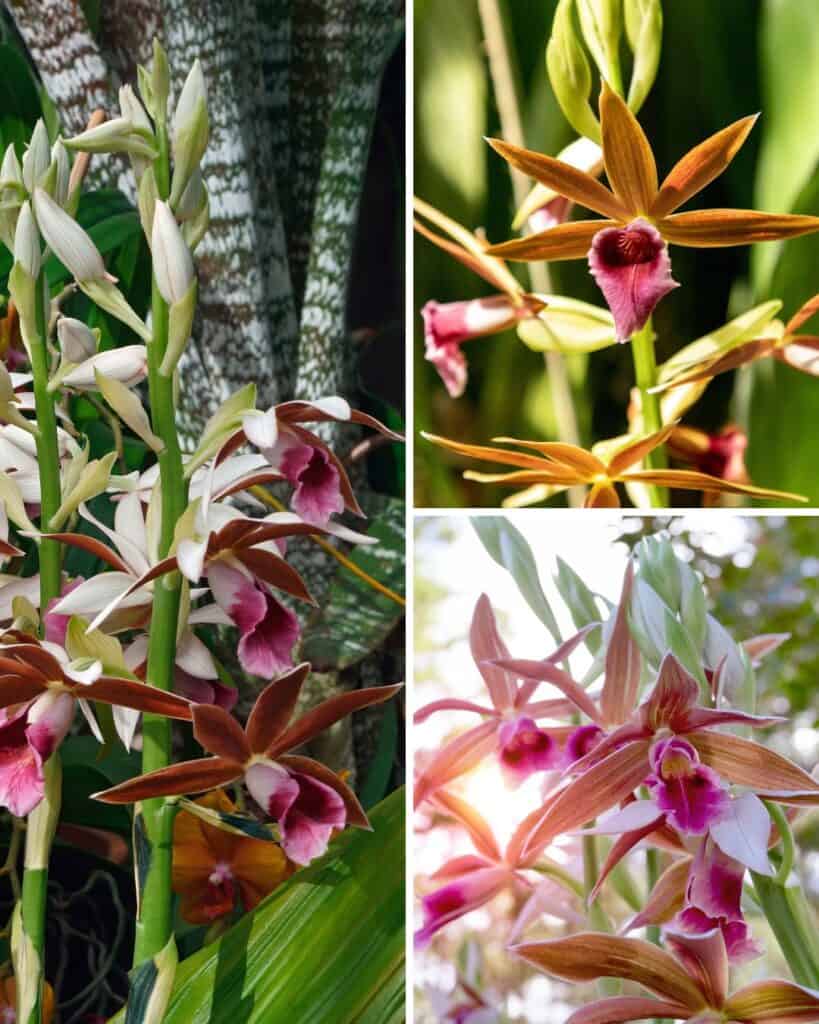The Phaius tankervilliae or Phaius tankervilleae, also known as the Phaius Nun’s orchid or Nun’s Cap Orchid, is one of the easiest orchid species to grow at home.
It’s native to native to China, Hong Kong, Taiwan, the Pacific Islands, Malaysia, Thailand, and Indonesia.

The handsome foliage of the nun orchid is large and palm-like, with individual leaves being from 2′ to 3′ feet long and 5″ or 6″ inches wide. Their growth is upright and compact.
On the other hand, the flower spikes on the nun orchid grow up to 4′ feet tall, so plants will take little room in your window.
Its common name references the throat of the flower, resembling a nun with her head bowed in prayer.
Other common names include:
- Swamp Lily
- Red Crane Orchid
- Veiled Nun Orchid
The white nun orchid blooms with a lot of flowers in colors of white, maroon, reddish brown, and pinky-yellow. These fragrant flowers last a very long time during spring.

The ground orchid is available online or by mail order from many orchid specialists.
However, due to modern-day cloning technology, more growers now grow Phaius orchid plants as a seasonal crop.
Phaius A Terrestrial Orchid
Unlike the cattleya or familiar corsage orchid, the Phaius is a terrestrial orchid plant, which means they grow in soil.

You may also like the Bletilla striata Ground Orchid
Caring For The Nun Orchid Phaius
Phaius, as a ground orchid, needs even moist soil and good light but avoids direct sunlight. The nun’s orchid will get along with a somewhat less humid atmosphere than cattleyas.
I know of someone who grows their Phaius tankervilliae all year round in their bedroom with a large picture window that faces almost due west. There it receives good light all day and warm temperatures.
During the fall and winter months, sunlight does not reach through to touch the plant until late afternoon, but this is filtered through curtains and doesn’t seem to bother the plant.

In summer, the direct and intense sun streams through the window shortly after midday. The window, with the curtains, provides good light even when drawn to protect the foliage from the sun’s burning rays.
No Dormant Period
As phaius seems to have no dormant period, this evergreen plant requires moisture throughout the year to live. This flowering plant grown in plastic pots required less frequent watering compared to the ones grown in clay pots.
I’ve found potted nun’s orchid plants in 6″ inch plastic pots needed watering only once a week in winter and twice a week in summer for optimal growth.
Once monthly, after watering, feed the plant a pint of weak liquid fertilizer of 20-20-20 or apply a slow-release fertilizer on the soil during their active growth.

Placing a pot on a saucer with pebbles and water or a humidity tray provides sufficient humidity. Don’t try to increase humidity by wetting the foliage, as the water-sensitive leaves may become damaged.
On hot summer days, however, the leaves may be lightly mist-sprayed. But don’t overdo it, and be sure to leave it dry by evening.
Blooming The Phaius A Nun Appears
Phaius may bloom in February, March, or April. Sometime in midwinter, a flower scape (or two or more) will appear from the base of the plant.
Growth is fairly rapid, but even so, you will watch for the orchid blooms daily, with expectant excitement at first and increased impatience later.

Then one day, you will stand in front of your phaius, as the lower bud on the scape unfurls its handsome tan-and-white petals – some of the new hybrids are rust orange.
You’ll awake one morning early in March to find that the first bud had opened sometime during the night.
The Phaius tankervilleae bloom, about 5″ inches wide, has petals bone-white on the back, the front a lovely tan edged with a thin streak of bone-white.
The tubular lip, or labellum, about 2 inches long, was a lovely shade of carmine-red, the edge frilled and touched with that same tan.
Put your eye to the lip to see the “nun” inside and experience a thrill.
Looking inside the labellum of the phaius orchid will produce a thrill when you see the nun. However, you will get a better view if you carefully part the labellum.

The column inside resembles a nun, even to the hood on her head and her two tiny black eyes!
Individual blooms last about ten days to two weeks before deteriorating, but your plant will remain in bloom for at least a month.
When the last bloom fades, cut the scape off close to the bottom of the plant.
Propagation: New Nun’s Orchid From Old Flower Stems

Do not toss away the scape or flower stalk, as it is a source of new plants.
With a sharp knife, cut the flower stalk from the mature plant into about six-inch lengths, ensuring there are two nodes (swellings along the stem) to each.

Place the stems horizontally on vermiculite, keeping the medium damp, and place in a warm, shaded spot.
Many of these will undoubtedly rot (they do for me as well), but some with dormant eyes will sprout to increase your stock of plants. New plantlets will be large enough to detach from the stapes in four or five months.
Plant them using a potting mix like a “miracle grow mix, ” coco peat, perlite, pine bark, and even in moist sphagnum moss. Just make sure the potting mix is also well-drained soil.
However, a quicker way to increase your stock of blooming-sized plants is by dividing pseudobulbs. Put each bulb in a separate pot.

